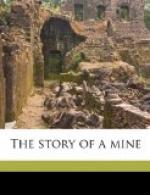He came!
But not as the Prince should come, on a white charger, to carry away this cruelly-abused and enchanted damsel. He was sunburned, he was bearded like “the pard”; he was a little careless as to his dress, and pre-occupied in his ways. But his mouth and eyes were the same; and when he repeated in his old frank, half-mischievous way the invitation of his letter, poor little Carmen could only hesitate and blush.
A thought struck him and sent the color to his face. Your gentleman born is always as modest as a woman. He ran down stairs, and seizing the widowed Plodgitt, said hastily:
“You’re just killing yourself here. Take a change. Come down to Monterey for a day or two with me, and bring miss De Haro with you for company.”
The old lady recognized the situation. Thatcher was now a man of vast possibilities. In all maternal daughters of Eve there is the slightest bit of the chaperone and match-maker. It is the last way of reviving the past.
She consented, and Carmen De Haro could not well refuse.
The ladies found the “Blue Mass” mills very much as Thatcher had previously delivered it to them, “a trifle rough and mannish.” But he made over to them the one tenement reserved for himself, and slept with his men, or more likely under the trees. At first Mrs. Plodgitt missed gas and running water, and these several conveniences of civilization, among which I fear may be mentioned sheets and pillow cases; but the balsam of the mountain air soothed her neuralgia and her temper. As for Carmen, she rioted in the unlimited license of her absolute freedom from conventional restraint and the indulgence of her child-like impulses. She scoured the ledges far and wide alone; she dipped into dark copses, and scrambled over sterile patches of chemisal, and came back laden with the spoil of buckeye blossoms, manzanita berries and laurel. But she would not make a sketch of the “Blue Mass Company’s” mills on a Mercator’s projection—something that could be afterwards lithographed or chromoed, with the mills turning out tons of quicksilver through the energies of a happy and picturesque assemblage of miners—even to please her padrone, Don Royal Thatcher. On the contrary, she made a study of the ruins of the crumbled and decayed red-rock furnace, with the black mountain above it, and the light of a dying camp fire shining upon it, and the dull-red excavations in the ledge. But even this did not satisfy her until she had made some alterations; and when she finally brought her finished study to Don Royal, she looked at him a little defiantly. Thatcher admired honestly, and then criticised a little humorously and dishonestly. “But couldn’t you, for a consideration, put up a sign-board on that rock with the inscription, ’Road to the Blue Mass Company’s new mills to the right,’ and combine business with art? That’s the fault of you geniuses. But what’s this blanketed figure doing here, lying before the furnace?




